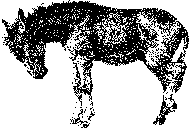
South Germany
Last fourth of the 15th century
Polychromous lime tree
H. 1.22 m; L. 1 m; Pr. 0.44 m
Old collection W. Hoffstatter
Bought with the help
of the Association for
the Enlightening of
the National Museum of the Middle Age (ARMMA)
Cl. 23799
Christ of the Palms

Musée de Cluny, Paris
Statue on wheels of Christ and the donkey, used in Holy Week processions to depict the Triumphal Entry.
The representations of the Christ of the Palms in the round, placed on the wheeled carts, and designed to be moved when there were processions, are one of most typical and remarkable productions of the south west provinces of Germany between the end of the 12th century and the end of the 16th century, the Reformation or the Counter Reformation, having ended this type of work..
At first analysis, the work is made of seventeen pieces of wood: the board and the four wheels, the four legs of the donkey, its tail, its ears, Christ’s left hand, his two feet, and two more important pieces; one making the donkey's body and the lower part of Christ's, and the other the torso and the head. These two pieces are joined to a third one which is relatively thin. The donkey’s tail and Christ’s left hand are modern pieces fixed with internal screws. The feet were assembled with nails, but one of them has been repaired. The other pieces were assembled with plugs or mortice and tenon. The work, although it has been repainted, retains patches of the original polychromy (Christ's head, the lining of the dress, possible the carnations in the right hand, the braid, and part of the donkey's hair).
Christ is sculpted nervously and sharply, conferring to the piece a majesty that compensates for the slightly clumsy character of the donkey. The incorporation of this work of art in the collection of the National Museum of the Middle Ages illustrates one of the most remarkable forms of medieval devotion, the use of animated sculptures to represent certain parts of the Biblical story, especially around the cycle of Easter. Already known in Jerusalem in the 4th century, the Palm Sunday procession takes a new dimension in the 10th century when, as noted in the life of Ulrich , bishop of Augsburg, clerics introduced into it a new element, a sculpture representing Christ sitting on his donkey, placed on a carriage or on wheels, which was taken in procession from a church which represented the Mount of Olives, to another church representing Saint Sepulcher, the destination of the hyerosolimitan processions. Although the oldest examples, like the Steinen one in the Suisse National Museum of Zurich, were made in the 12th century, most of the those which have survived belong to the same period as the one just acquired by the museum, i.e. the 15th century and beginning of the and 16th century.
http://www.musee-moyenage.fr/ang/pages/page_id18570_u1l2.htm







No comments:
Post a Comment